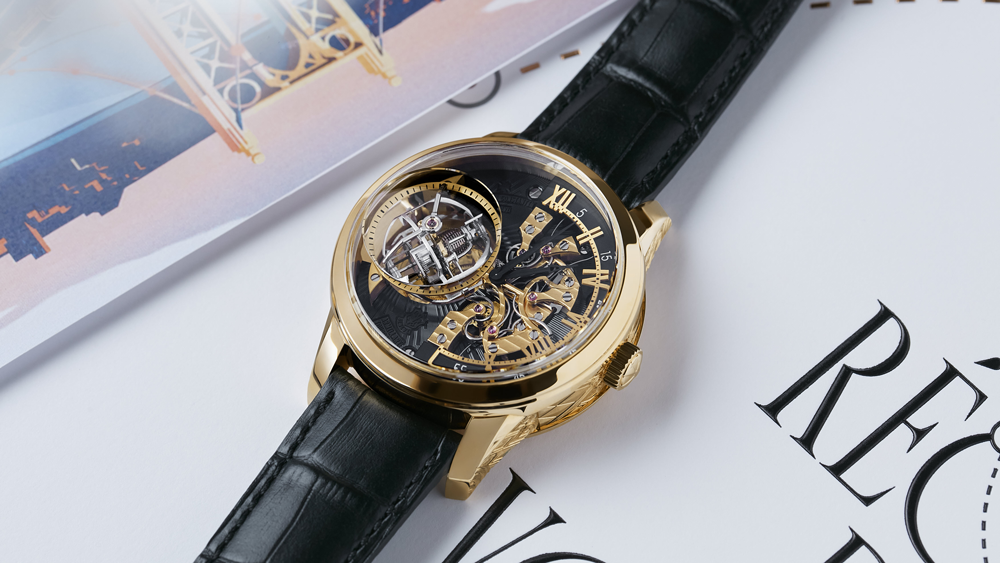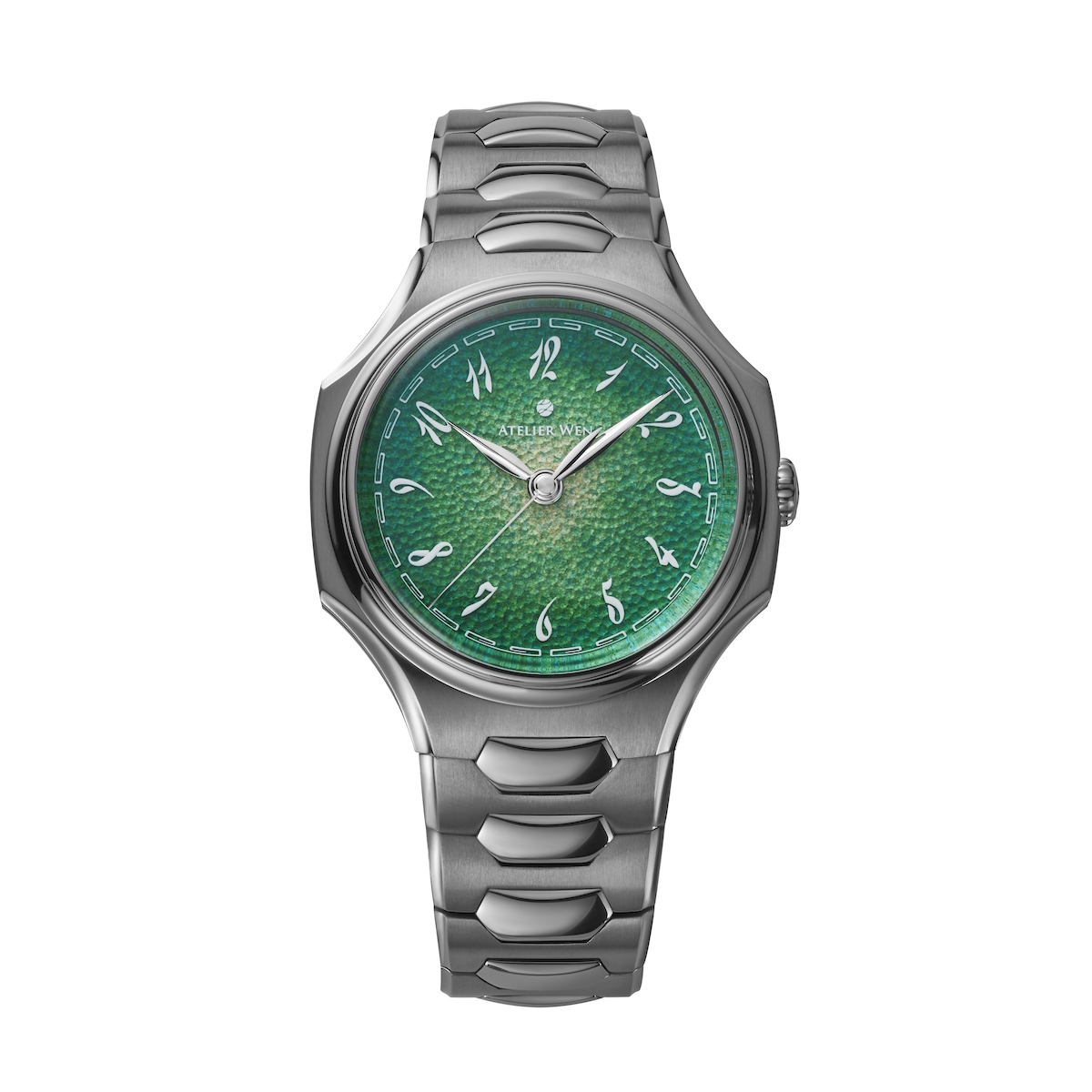You would not be wrong if you called Vacheron Constantin‘s Les Cabinotiers collection ostentatious or over-the-top. But you would be remiss to not notice that these are, in fact, works of art. One could argue that many pieces that come from the hallowed halls of Switzerland’s greatest watch manufacturers are true feats of both technical ingenuity and nearly insane levels of artisanal hand-craftsmanship. Each Les Cabinotiers piece, however, is on another level entirely. These are one-of-a-kind pieces displaying some of the best work watchmaking can offer by living hands.
It is this specialized arm of Vacheron Constantin’s manufacture that created its most complicated watch ever, the Ref. 57260. For the last seven years, it has been devoted to turning out some of the wildest, most-ornate, and most-complicated watches on the planet. This year was no exception, with the house debuting 11 special creations to a select group of journalists in the desert of Dubai before even clients were able to take a look. All were devoted to extraordinary destinations from Paris to New York to China.
Originally, Les Cabinotiers was devoted solely to custom orders—which it still fulfills—but for the last seven years, the company has used its know-how to develop spectacular creations outside of its bespoke requests in order to create awareness around its deep level of expertise. But catering to clients that are used to having their wishes realized sooner rather than later was also an impetus. “When I joined the company seven years ago, I realized that a lot of our clients were quite impatient and when you say to them, ‘Ok, we can do it, but it’s going to take three to four or five years, which is usually the time that it takes, we were losing a significant part of the clientele,” says Vacheron Constantin CEO, Louis Ferla, who began working at the company in 2016 as its managing director of sales and marketing before taking over the reins of the house a year later. “So, we decided to shift our business model a little bit to offer one collection per year of unique, amazing pieces.”
The last public event held to debut a new Les Cabinotiers collection was held in Singapore in 2019. Covid, naturally, threw a wrench in scheduled plans. And, although Ferla says the company had enough pieces to show in 2022, and they could have done it, the company had pre-sold every single piece. “We had almost nothing to show,” he says. That’s why this year, the company chose to hold pieces back to first show to press and then to clients in an unusual twist on the traditional order of operations for high-end watches. But pay attention to what you see; while you might not get your hands on one of these ultra-ultra-exclusive pieces, they are often springboards for what you might see in a future series production watch. According to Ferla, “What you will see in the next few years, in terms of complications and métiers d’art will be mind-blowing.”
Minute Repeater Tourbillon-Tribute to Arabesque

VACHERON CONSTANTIN
In terms of the execution of craftsmanship, there is no doubt that the Minute Repeater Tourbillon-Tribute to Arabesque is the most spectacular of the new Cabinotiers releases. Its incredibly intricate engraving takes its design cues from the Sheikh Zayed Grand Mosque in Dubai, the largest in the U.A.E., by recreating the arabesque and floral patterns of its 82 domes and minarets via line engraving and bas reliefs techniques done by hand. The level of detail is truly extraordinary. Pictures can hardly do justice to the level of execution on the dial, bezel, case, and buckle. To put into perspective just how challenging it is to engrave the 18-karat white-gold lace-like motif, the thickness of the lines on the dial is just 0.1 mm in some areas. The hand-engraving took three months worth of work.
But no detail was spared anywhere. One might not notice initially that beyond the detailed white-gold art on the dial lies another layer that has also been adorned with the most minute décor. “We have the base dial in white gold which has been hand-chiseled point by point [roughly 1,000 points], which is a technique that is extremely rare because it takes a lot of time and then we have applied a black coating on it,” says Christian Selmoni, style and heritage director at Vacheron Constantin. “Why did we use a point-by-point technique? Because it gives us a lot of contrast.”
For a piece of this nature, no ordinary complication would do. At six o’clock you can spot the tourbillon with the company’s signature Maltese cross motif. It also houses a minute repeater with both complications combined in the 2755 TMR movement set within the 44 mm by 13.5 mm white-gold case.
The significance of this piece was not simply to choose an Arabesque motif and present it in a Middle Eastern country to drive home the theme—Vacheron Constantin has a rich history in the region dating back to the 19th century. It began trading with Turkey during the Ottoman Empire from 1817 and later with Egypt starting in 1865. High-profile clients from its past have included everyone from Saudi Arabian King Abdelaziz Ibn Seoud to King Fouad I of Egypt. Naturally, today’s clients are kept under wraps but one would suspect they might be of the same caliber as their predecessors.
Minute Repeater Tourbillon-Tribute to Art Deco Style

VACHERON CONSTANTIN
Another outstanding dial treatment was arranged for another minute repeater tourbillon using the same Caliber 2755 TMR mentioned above, but this time in homage to Art Deco and New York City skyscrapers, most evidently the Chrysler Building. At first glance, it’s more minimal in style than the Tribute to Arabesque style (which will appeal to clients of different taste), but its execution is almost just as painstaking.
The dial is done in two layers of champlevé wood micro-marquetry, a first for the company. In most cases, champlevé—a decorative art form that uses a powdered glassy material fused into a recess in a metal surface through the application of heat—are used for enamel dials. Here, however, the technique is deployed by applying 110 tiny pieces of wood, which had to be cut “insanely precisely” in order to fit into the champlevé metal outlines, according to Selmoni. The second layer is also created in the same vein. The process begins with a deep-staining and then sanding of pear wood and tulipwood to create the black and blue shades before cutting each piece. It takes a full month of work to complete by one single artisan, who, according to Selmoni, is an artist in his 30s that is one of the very few people on the planet able to achieve this kind of work.
The 44 mm by 13.5 mm 18-karat pink-gold case and buckle is hand-engraved with a chevron-style pattern in keeping with the era of inspiration. The hour markers coming in baguette-cut diamonds while the minutes are indicated by tiny, elegant gold “pearls.”
The 1920s were a particularly fruitful time for Vacheron Constantin—many of its watches from the era have become collector darlings. While the company had a presence stateside as far back as 1810, it was during the roaring twenties that the watchmaker firmly established itself among the country’s elite. The Rockefellers, Henry and William James, and the car manufacturer James Ward Packard were all clients.
Armillary Tourbillon-Tribute to Art Deco Style

VACHERON CONSTANTIN
At 45 mm by 20.5 mm, this is by far the heftiest watch in the collection. While no piece in this Les Cabinotiers line is for wallflowers, this piece surely made for the boldest client in Vacheron’s fold. It is as heavy as it looks and that’s with good reason. The 18-karat yellow-gold case had to make room for the horological show within. It houses a bi-axial armillary tourbillon at nine o’clock with a spherical balance spring—an aperture on the side of the case allows for a second view of the highly technical component, while a bubble in the sapphire crystal was created to make more room for the spinning piece. The two interlocking aluminum carriages each rotate at a speed of 60 seconds. The right side of the watch is reserved for the bi-retrograde time display.
The Caliber 1990, not surprisingly, boasts four patents: one for the instantaneous retrograde system controlled by a single minutes cam that synchronizes the jump of the two hands at midnight or noon; a titanium escapement collet that secures the inner end of the balance spring; another for the architecture of the tourbillon carriage that rotates every 15 seconds to form the Vacheron Constantin Maltese cross; and one for the silicon escapement wheel, which has diamond-polished patents that offer greater resistance to wear and friction.
It wouldn’t be a Les Cabinotiers piece without using its surfaces for métiers d’art purposes. Here, Art Deco-style engraving was done on everything from the case to the movement, which, for the latter, involved reworking the bridges and plate of Calibre 1990. The back of the movement shows three engraved bridges decorated in the vein of design elements of New York City’s ’20s-era skyscrapers. It took one month for an engraver to complete these components alone.
It’s hard to imagine anyone wearing this piece with more frequency than a few times a year, both because it is extraordinary in scope but also in sheer volume. It is certainly an anomaly in the ever-increasing realm of smaller watches that are becoming more and more popular. But this one is for the true horological aficionado, someone who will likely, on occasion, show off this piece to the right crowd to wax on about its technical achievements as though talking about the nuances of a Picasso hanging on a wall. Of course, one can never tell. Singular pieces are for singular clients after all.
Malte Tourbillon-Tribute to Haussman Style

VACHERON CONSTANTIN
Both the movement and the case are engraved to the hilt on this gilded artwork. A single master engraver was responsible for its decoration. The details are reminiscent of Baron Haussmann’s work in Paris during the mid-19th century under the order of Napoleon III. A representative for Paris at the time, he was ordered to redesign the city. It was under his direction that large streets like the Champs Elysée and the Rue de Rivoli were created to take the city from its Middle Ages layout of small, shabby streets to grander, more modern avenues. He also had strict architectural rules and was particularly stringent about design—much of Paris still boasts his work, which is why it is largely considered one of the most beautiful cities in the world.
Haussmann’s work inspired the architectural details of this skeleton watch, while his decorative motifs, such as the lion, are featured on the 18-karat pink-gold case. The raised effect on the dial is created using champlevé by removing the material around drawn motifs using a burin. The lion corresponds to 4/10ths of a millimeter, while its frieze is 2/10ths. Some of the details on the movement components also pay respect to the Eiffel Tower, another, far different Parisian marvel erected shortly after Haussmann’s death.
Keeping the piece in operation is the Caliber 2790 SQ, which contains a tourbillon at six o’clock, a date display at one o’clock, and power reserve at 10 o’clock. It comes set within the 41.5 mm by 38 mm by 12.5 mm 18-karat pink-gold Malte case, a signature of Vacheron Constantin first introduced in 1912. Its shape perfectly corresponds to the history that inspired it, showing an expanding middle that makes room for its exquisite decor while its skeletonize movement creates air to show off its architectural beauty.
Grisaille High Jewelry Dragon

VACHERON CONSTANTIN
Like a tattoo for the wrist (albeit one you can remove), the green enamel of the Grisaille High Jewelry Dragon is a first of its kind for Vacheron Constantin, as is its combination with gem-setting. “This is a kind of double Grisaille enamel and, personally, I don’t know of any other example of such mix of technique for Grisaille enamel,” says Selmoni. It is made using two layers of black enamel and then the dragon is drawn using a rare white enamel known as Limoges to a dark enamel base. Each layer is fired in a kiln timed to the nearest second with the details of the dragon taking shape with each firing. A final layer of lapped green translucent enamel is applied to achieve the depth and contrast in the image.
While the rich green tint is applied over the white Limoges enamel drawing, final touches of Limoges white are applied by the enameler while being fired in the kiln to finish the subtleties of the five-clawed dragon—a symbol of power, nobility, and good fortune, surely something anyone that buys this piece has in spades already. It is encapsulated in an 18-karat white-gold case set with 146 baguette-cut diamonds and paired with a dark green alligator strap with a white-gold buckled sporting 16 baguette-cut diamonds.
At 40 mm by 8.9 mm, it is arguably more wearable than the above pieces. It owes its slimness to the caliber 1120, which was introduced in 1968 and redesigned in 2010, keeping its thin profile but increasing the power reserve to 40 hours. The dragon is far more subtle in person than is pictured and from an aesthetic point of view is certainly the coolest and most wearable in the lineup.
Memorable Places

VACHERON CONSTANTIN
A quartet of timepieces are dedicated entirely to intricate (and truly exceptional) engraving work. Dubbed “Memorable Places” each is devoted to wonders around the world including Angkor Thom in Cambodia, the Temple of Confucius in Beijing, and the former Chinese imperial Old Summer Palace—all executed in 18-karat yellow gold, pink gold, and white gold on the dial and set within a 40 mm by 9.10 mm 18-karat pink-gold case. The fourth is specially set in an 18-karat white-gold case as its scenic portrait is dedicated to the Tour de L’Île—the site of Vacheron Constantin’s historical headquarters in Geneva.
The dials are composed of several plates cut from yellow, white, and pink gold which are engraved using micro-sculpture techniques and then fit together. Each plate is only 0.4 to 0.8 mm thick, which means the engraver cannot go deeper than 1 to 2/10ths of a millimeter while engraving. Two hundred hours are thus required to create a single dial. In the case of the Angkor Thom and Imperial Summer Palace pieces, the tree foliage was created using a damascene technique, which required embedding metal wire in an engraved surface.
The incredible detail with which these are created is astounding. Only by viewing them through a loupe can you truly appreciate the level of craftsmanship required to create each one. It seems a shame that such pieces will only be seen by so few in the world—a sentiment that could be expressed for each and every piece in the collection.
Click here for more photos of the Vacheron Constantin’s 2023 Les Cabinotiers collection.










